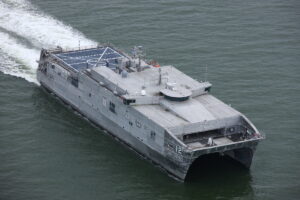The future Spearhead-class expeditionary fast transport ship USNS Apalachicola
(EPF 13) successfully finished Acceptance Trials and Unmanned Logistics Prototype Trials, the Navy said on Sept. 9.
Whereas the acceptance trials consisted of a standard series of in-port and at-sea demonstrations to allow the shipbuilder, Austal USA, and the Navy to assess ship systems and readiness before delivery, the unmanned trials are a new feature for this specific vessel.
In 2021 the Navy awarded Austal USA a $44 million contract modification to build and demonstrate a larger manned ship can be fielded with some autonomous capabilities as a self-driving platform (Defense Daily, June 9, 2021).

At the time, Austal said enhancements include installing a perception and autonomy control suite, automation enhancements to the machinery plant that improve the hull, mechanical and electric reliability, and reducing the amount of personnel needed for operations at sea. The company argues the base EPF was previously designed to already include an automated machinery plant to centralize operations on the bridge, require a smaller crew, and save costs.
Now these Unmanned Logistics Prototype Trials assessed the autonomous capabilities integrated into the shipboard configuration, “demonstrating that a large ship can become a self-driving platform,” the Navy said.
The service noted that as the ship sailed from the Austal shipyard at Mobile, Ala., to Miami, Fla., the Apalachicola sailed in autonomous mode for about 85 percent of the at-sea period.
The Navy said during the voyage EPF-13’s autonomous system completed a stress test in high-traffic coastal areas “by taking appropriate ship handling actions while operating around other ships, boats, sailboats, and craft.”
Last month, the Navy revealed it was conducting the Unmanned Logistics Prototype Trials to increase the perception capability and behavior complexity performed by the autonomous systems. At the time, the test evolutions included point-to-point autonomous navigation, vessel handling and transfer of vessel control between manned to unmanned modes (Defense Daily, Aug. 3).
At the time, the Navy said future test events will add more difficulty levels with night navigation and differing weather and sea states. It also noted the trials set the groundwork for other autonomous operations, like vessel encounter and avoidance maneuvering and compliance with International Regulations for Preventing Collisions at Sea, known as COLREGS.
The service said this “unprecedented development of autonomous capability on Apalachicola” is thanks to combined efforts by the Navy, Austal USA, L3Harris Technologies [LHX] and General Dynamics [GD].
“The ability to expand unmanned concepts into the existing fleet was validated by these trials. The capabilities integrated onto EPF 13 set the groundwork for future autonomous operations,” Tim Roberts, program manager for Strategic & Theater Sealift within Program Executive Office (PEO) Ships, said in a statement.
Roberts also said said that “Apalachicola will enhance the operational flexibility needed by our Sailors.”
EPF-13 is expected to be delivered to the Navy later this year and be ready for use and deployment by 2023.
The Spearhead-class ships are generally shallow draft vessels designed for quick intra-theater transportation of personnel and equipment. They can load and unload in austere ports.